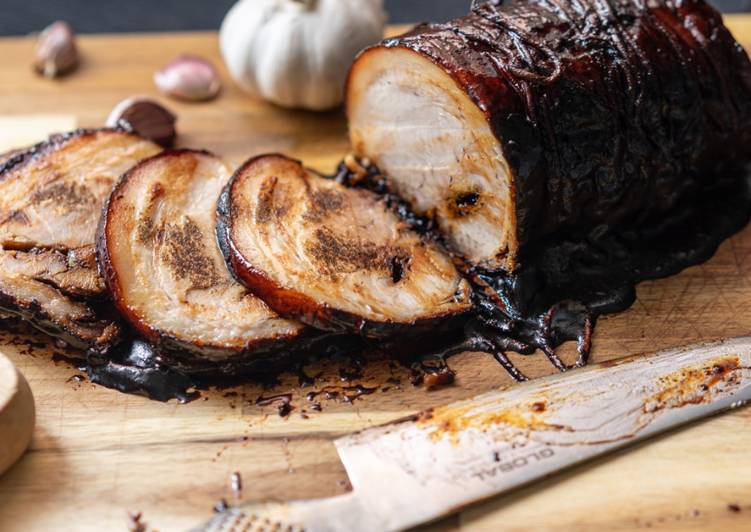
Hey everyone, hope you’re having an amazing day today. Today, I’m gonna show you how to prepare a distinctive dish, homemade japanese chashu (braised pork). One of my favorites food recipes. This time, I will make it a bit tasty. This is gonna smell and look delicious.
In Japanese, Chashu is sometimes called "Nibuta" (煮豚), literally means simmered/braised pork, as opposed to "Yakibuta" (焼豚), which means barbecued pork. The Japanese enjoy Chasu as a topping for Ramen and other noodles, as well as Chasu over steamed rice in called Chashu Don, like a rice. Full recipe: www.xkindeep.com Instagram: www.instagram.com/opps_itseli A bowl of ramen is incomplete without this sensational topping, The Japanese Chashu.
Homemade Japanese Chashu (Braised Pork) is one of the most favored of recent trending foods on earth. It is appreciated by millions daily. It is easy, it’s quick, it tastes yummy. Homemade Japanese Chashu (Braised Pork) is something that I’ve loved my entire life. They are nice and they look fantastic.
To get started with this particular recipe, we must prepare a few components. You can cook homemade japanese chashu (braised pork) using 14 ingredients and 24 steps. Here is how you can achieve that.
The ingredients needed to make Homemade Japanese Chashu (Braised Pork):
- Take Meat
- Get Square slice of Pork Belly
- Make ready Cooking Oil
- Make ready Marinating Sauce
- Make ready Dark Soy Sauce
- Make ready Brown Sugar
- Prepare Sake
- Make ready Water
- Take Spring Onions
- Make ready Ginger
- Get Garlic
- Prepare Others
- Make ready Ball of Cotton String
- Make ready Salt
They don't look anything alike because they aren't: char siu is roasted, whereas. This Japanese adaptation of the Chinese dish char siu is seasoned with sugar, sake and dark soy sauce and braised at a low temperature for a few hours. Chashu (Braised Pork Belly) recipe for topping of tonkotsu ramen noodles. It could also be used in rice saute, fried noodles or pizza topping.
Steps to make Homemade Japanese Chashu (Braised Pork):
- Rough cut ginger with skin on
- Cut spring onions into halves
- De-skin garlic
- Add all marinating sauce ingredients into a saucepan
- Bring it to boil, stir and turn the heat off immediately
- Use coarse salt to clean & exfoliate meat
- Rinse the salt off with clean water
- Roll pork belly into a log
- Tie up rolled pork belly
- Pan-fry rolled pork belly for 2 mins per side until it's golden brown
- Put fried rolled pork into boiling water for 1 hour
- Remove pork belly from boiling water
- Pour marinating sauce into a shallow pan deep enough for your pork
- Heat up marinating sauce to boil
- Once it's boiling, turn the heat down to the lowest
- Add pork into pan and cover it with a drop lid or seal it with an aluminium foil, and make a small hole in the middle.
- Braise each side for half an hour (Total 2 hours)
- Transfer braised pork into a ziplock bag
- Use a strainer and strain remaining sauce into the ziplock bag
- Squeeze the air out and seal it tight
- Store it in the refrigerator overnight or 24 hours to marinate
- Remove braised pork from the ziplock bag
- Slice it thinly
- You may choose to blowtorch or pan-fry it to bring out the smokey taste.
I will post series of ramen (Japanese noodles) making for the next few days. This chashu pork (pork belly braised in soy sauce, sake, and mirin) is the perfectly tender addition to your next bowl of ramen. Chashu is one of the basic and most popular toppings found atop ramen. You may recognize Chinese Char-siu by its signature red exterior and lean meat where Japanese Chashu is Chashu can be made from different cuts of pork but is traditionally tied up so that it can be sliced round. This is the Japanese chashu pork you find served with ramen noodles.
So that is going to wrap it up for this exceptional food homemade japanese chashu (braised pork) recipe. Thank you very much for reading. I am confident that you can make this at home. There is gonna be interesting food in home recipes coming up. Remember to bookmark this page on your browser, and share it to your family, friends and colleague. Thanks again for reading. Go on get cooking!


